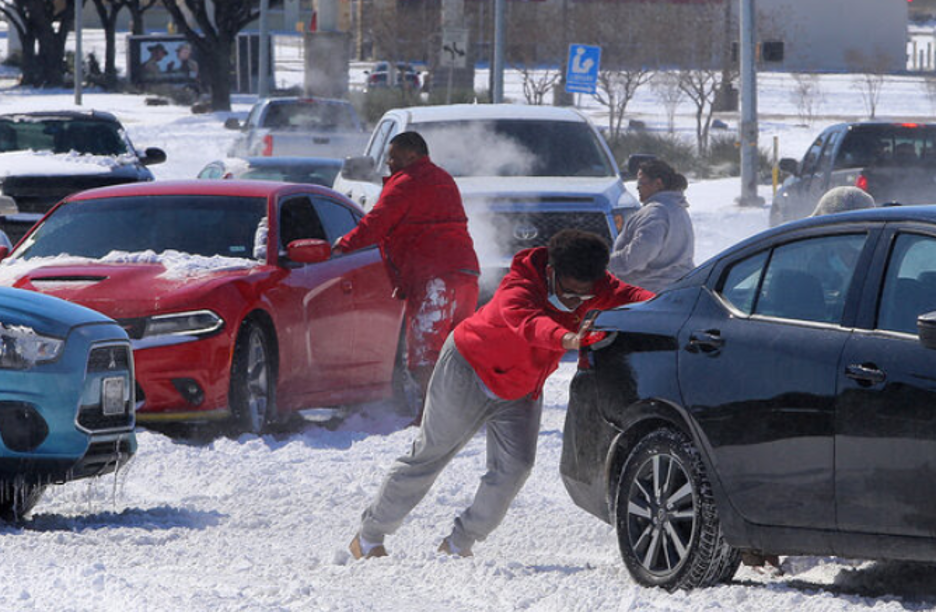
This is Waco, Texas last week. It was worse all over the Midwest and on the east coast. Looks like fun, yes?
It’s why we live in Tucson. I share it, so we start off this week on a ‘high fives all around’ note.
The last time I drove in Michigan, I ended up stuck in a snowbank. I feel for those people in the picture and all over Texas.
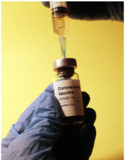
Vaccine Update
Last week I wrote a bunch about the state and UA plan to open their own Point of Distribution (POD) on the UA mall. My point was that doing so would simply be decreasing the number of vaccine doses available to the county for their own PODs. Last week, County Administrator Huckelberry sent out a memo that affirmed the concern. It additionally made the point that state-run PODs are not targeting vulnerable populations. Here are a few snippets from that report.
To highlight the point about decreasing vaccination deliveries from the state, check out this chart. It clearly shows how our allocation has been reduced.
|
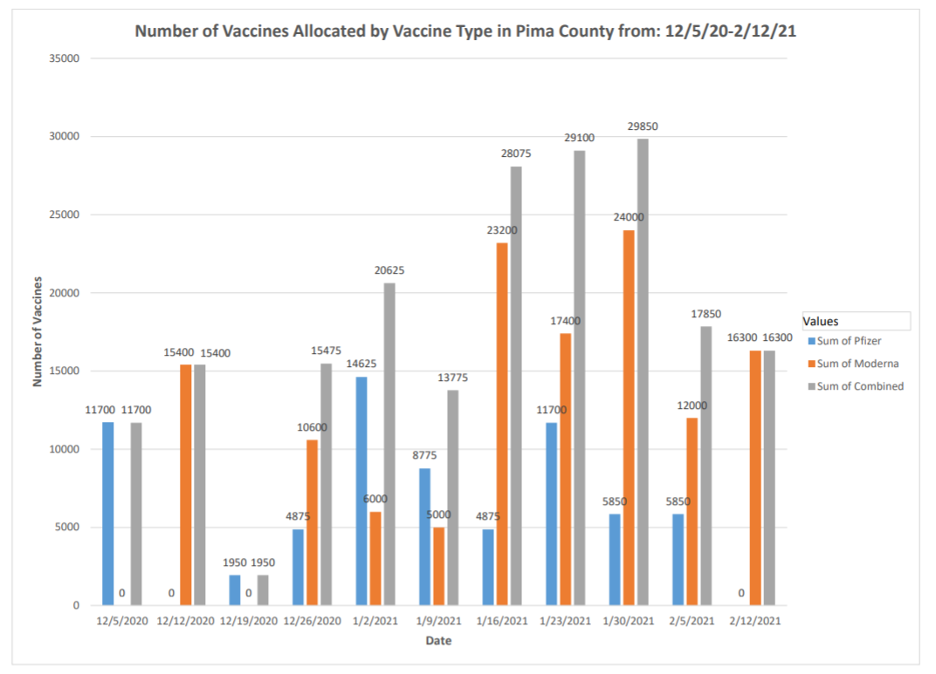
Specifically, look at the very last allocation shown. The blue bar is the number of Pfizer doses the state sends to us. During the week of 2/12, we got zero. That’s noteworthy because only Pima and Maricopa Counties can use Pfizer due to the controlled temps it has to be stored and used at. Overall we’ve been getting 10% of the Pfizer allocations. Maricopa County has gotten 90%. The week of the 12th, we got none.
UA President Robbins sent out a letter last week in which he indicated a desire to be a good community partner with the city and the county. Stepping into a relationship with the state to begin a UA mall Point of Distribution (POD) while our doses are being reduced is not partnering. Here’s a part of that letter:
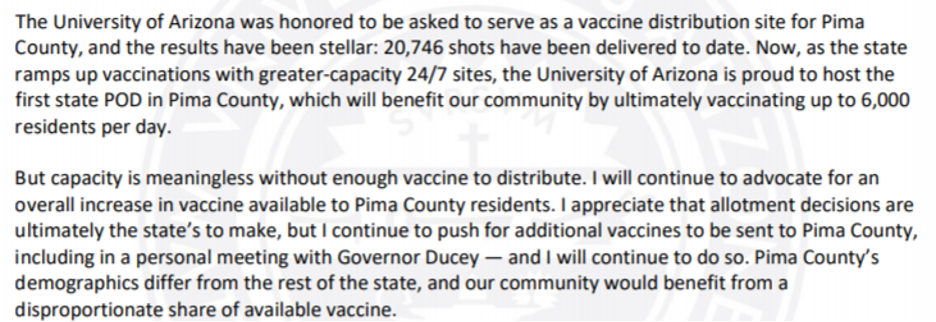
The UA had no business going solo with the state while the rest of the county was struggling to get doses. The only meaningful statement in that quote is ‘capacity is meaningless without enough vaccine to distribute.’ During our joint city/county meeting held last week, I asked if the county had received a response to its request for 39,400 doses. The only reply was to hear the countywide total is being reduced to 17,000 this week. The TCC had to cancel appointments all week. Pima County getting 10% of the state-distributed Pfizer doses is not sufficient. A true partnership would have been the UA sitting down with the county health people and agreeing to delay ramping up the mall site until enough doses are available for the county to continue mobile vaccination sites that take care of populations who cannot get through the state registration system, or make it onto the mall. I’m not alone in that thinking. County Administrator Huckelberry wrote this to the Board of Supervisors:
We understand the target capacity of this POD is to be 6,000 per day. I have, since the beginning of planning for this State-run POD, continually cautioned that it should not open until there is an assured vaccine supply as our existing PODs in Pima County are concurrently using all the vaccines that can be supplied by the State. Based on the States lack of assurance about the required vaccine supply for Pima County, I do not understand the push to open another State vaccination site at the University of Arizona at this time.
The county sites have been prioritized based on age vulnerability and disadvantaged communities. The most vulnerable communities often are those who will have the least available access to medical care, who have been hit hardest by loss of employment, who have the least access to transportation, and therefore have historically delayed access to medical interventions. The county mobile sites were being effective in reaching that group. Of the 511 vaccines given at a recent such mobile site, this is the ethnic breakdown of who received the doses:
Over half of the Hispanic group included in that effort were Spanish-only speakers. Contrary to that, here’s how state-run PODs fare from a demographic standpoint:
 In Pima County, nearly 14% of people overall who have received a first dose are Hispanic. Nothing Robbins and Ducey have set up at the UA, or at any other state, POD comes close to that. The county has the capacity to administer 8,000 doses per day. The supply has averaged 3,600. Now it’s 2,400. It’s a reason to bring back my Penguin buddy to make the point:
Or if you prefer, quoting Voltaire: “Every man is guilty of all the good he didn’t do.” Jerking around regional partners isn’t ‘good.’
Until this gets sorted out, the county will have to go to a tiered vaccination system. Tier 1 will include certain assisted living facilities not enrolled in the federal program. So far, residents in only 21 of the 83 regional facilities who are in that group have been vaccinated. Tier 2 will include vulnerable populations based on age, ethnicity, disability, and low income. Generally those who will need the services of the mobile sites. Tier 3 includes people getting their 2nd doses who were a part of the county's 1st dose process. Those groups will take up the available doses for a while, especially if the UA continues it’s deal with the state to jump their quantity up to 6,000 per day. Guaranteed if they do that and the county allotment isn’t increased significantly, there will have to be yet another reassessment of who’s getting vaccinated at county-run sites.
It is important to remember that the County’s call center will not be able to assist community members who are attempting to register on the UA’s registration website, which is www.azdhs.gov/covid19vaccines . If calls are received at county sites regarding State registration, they will be referred to the helpline established by the State, which is 1-844-542-8201.
The maps and charts I usually include showing which Phase the various counties are in are relatively meaningless while the State/UA POD is taking local doses.
Use this county link to register for their PODs. It includes pharmacies, as well.
As of Friday, the county had vaccinated over 200,000 people, 50,000 of whom have had both a first and second dose. Of the people over 70 years of age, 43% have been vaccinated.
And here’s the Bloomberg COVID19 Tracker data for Arizona. The nationwide total is 19 doses having been administered per 100 people. Arizona had been lagging the nationwide total from the start, but in the past week, we passed the national average. And we went from 3.6% fully vaccinated last week to over 5% this week. Combine the 15% of the statewide population that has had at least one dose with the roughly 12% of the population that has some inherent immunity from having contracted COVID, and we’re at around 27% of Arizonans with some level of immunity. The level, and the duration of that immunity is unclear, but it’s certainly a step in the right direction. It’s also worth noting the report that came out last week about the new variant being the wild card when it comes to whether or not people who’ve been infected with the COVID we’ve been living with for the past year can become reinfected. We don’t know yet.
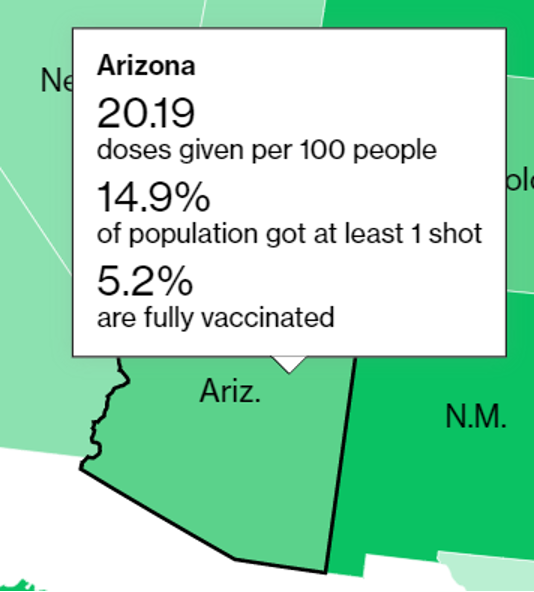 |
If you need a hand with the Pima County registration process, please call either 324.6400 or 222.0119. Things change every day with this program, so don’t hesitate to call them if you’re unsure at any point in the process.
COVID and State Transparency
The State of Arizona has received nearly $1.9B in federal COVID funding that could be distributed to Arizona counties. The state has distributed only $441M of that money. They also have $416M for testing and another $66M for vaccinations – none of which has been distributed to Pima County for either testing or vaccinations.
During our joint meeting with the county last week, staff indicated they had just received notice from the state that they’d be receiving about $14M to help with testing. That will carry them through the end of the month. At their March 2nd Board of Supervisors meeting, they’ll have to decide whether to continue to deficit spend, or suspend county-run testing and turn that over to the state. I guess if that happens, we’ll see if Robbins/UA wants to partner with the state on that, too. That’d certainly be ironic since it wasn’t long ago that the UA had asked the county to step up and take on their testing operation.
If testing and vaccines begin to come at a cost in March, look north to Phoenix for the cause. They continue to sit on hundreds of millions of dollars, refuse to allow counties to use any of it they dole out to reimburse for costs they’ve already incurred, have signed onto solo arrangements with the UA, and have identified no timeline for the full distribution of the remaining funds.
One of the Board members last week said he didn’t feel testing was worth continuing. He’s also the same guy who said wearing a mask is ‘anti-business.’ Testing is indeed important for us to continue. It’s how we find who to isolate, contact trace and ultimately control community spread. With the advent of the new variant strains, that is critically important at this time. We’ll all be watching to see if the state decides to allocate the funds it was given by the feds. The city and county are partnering in advocating with our federal delegation to get the money kicked loose.
Asylum Seekers
One issue Ducey has been in touch with D.C. about is the impending influx of asylum seekers. You remember the Benedictine operation. We don’t have that capacity now, so when the numbers begin to increase, we’ll have a new set of challenges.
Last week the Governor asked the feds how people will be monitored for COVID, how health care facilities are being prepared, how social distancing will be addressed, and how the Biden administration will deal with assuring they get to scheduled court hearings. During our meeting with Homeland Security 2 weeks ago, I made the point that we can manage the issues – if we have funding. Similar to the testing and vaccination issue, local governments cannot continue to fund these federal responsibilities. We’ll take on the management of the on-the-ground operation, but not at the expense of going into our general funds.
Understanding that reality, Representative Grijalva last week urged for more humanitarian funds for both cities and for non-profits to address how we’ll manage the increased numbers of asylum-seeking families. Here’s a quote from his letter:
“Throughout the years in my congressional district, non-governmental organizations, counties and cities have been at the forefront of assisting these families after they’re released from Department of Homeland Security (DHS) custody. With limited support from the federal government, they are helping them navigate a difficult and complex asylum process as they pursue their asylum claim through immigration court proceedings. As we continue to address this ongoing humanitarian crisis, I ask that you designate supplemental federal funds that can immediately be accessed by non-governmental organizations, counties, and cities that are assisting asylum-seeking families at the U.S.-Mexico border.”
That is the kind of outreach we need. We have capacity out at the Alitas Center for about 60 people. It was triple that pre-COVID, but due to distancing and health safety, the number is significantly reduced. Border Patrol and Homeland Security are prioritizing for removal of people they apprehend who pose a national security, border security, or public safety concern. Otherwise, we’re told to expect our numbers of migrant families to increase.
Catholic Community Services (CCS) continues to operate the Alitas Center. They’ll be supported by county rapid COVID testing, but as I mentioned above, funds for all of that are right now in question. In the past, FEMA reimbursed the county. It'd, of course, be great if the Grijalva letter kicked free some of those dollars now. Quoting County Administrator Huckelberry - “We have nothing to advance for reimbursement.” Correct – we've got budgets to manage. We need federal help. The Ducey letter did not advance that request.
While that funding fight is going on, I want to reiterate the need for donations. We have been continuing to receive them here at the W6 office throughout COVID, but now the need will clearly increase once again. I’m in the office daily, so reach out by email, and we’ll work out a way to meet/greet you and take what you can donate. The needs continue to be travel toiletries, little games for kids to play with, hygiene products, sunscreen, bottled water, and things you as a young mom and dad would pack if you were getting on a bus with little ones for a 3-day journey. You can email me directly at steve.kozachik@tucsonaz.gov, and I’ll work with you on coordinating the donation.
Thank you for all you’ve done when this issue got serious a few years ago. It’s about to again, so we can use your help.
PFAS and Midtown
Last week the mayor and Nikki Lee joined me in hosting a community dialogue on PFAS. We had representatives from Tucson Water, our City Attorney’s office, the DOD, and the Arizona Department of Environmental Quality (ADEQ) making presentations. The goal was to bring midtown neighbors up to speed on where the DM PFAS plume is, and what’s being done to assure our central city well field is safe. I believe the meeting achieved that end.
ADEQ is studying an area directly NW of the DM runway. It’s shown in orange on this map:
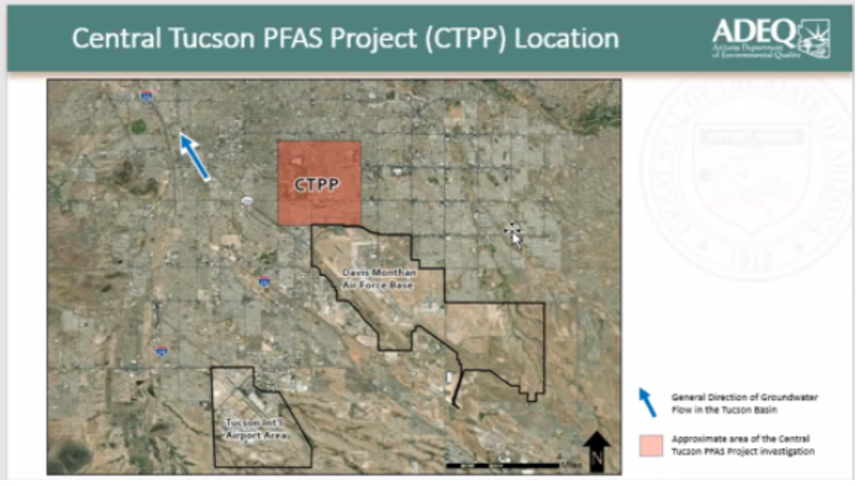 It’s within that area that we’ve had to shut down some of our otherwise active water wells. That’s due to the PFAS contamination that came from the base. In this image, look at the red dots that are just outside the runway (in grey.) They represent the wells we’ve shut down. The numbers you see (4710, 803, 952, 900, and 14,000) represent the amount of PFAS found in each location. Tucson Water shuts down wells when they’re found to contain over 18 parts per trillion of PFAS. You can see the reason for my concern.

The ADEQ has committed $3.3M to get a treatment system into place. Their goal is to have it operating by mid-next year. The full cost to treat the entire plume will, of course be well in excess of that few million dollars. We’re still in litigation against 3M and other manufacturers to recoup all of our costs.
Last week in Congress, a bipartisan caucus relaunched a Congressional PFAS Task Force, the goal of which is to advance a ‘culture change’ among Pentagon leadership related to the use of those chemicals. That’s nice, but what we need is funding from DOD to clean up their mess. Another task force studying what we know to be a local problem may be nice optics, but it isn’t paying the bills. Hope springs eternal with the new administration.
PFAS and the UA
While gathering a headline for setting up their state vaccination POD, the UA also announced they’re studying the impacts of PFAS on COVID. It’s intuitive – PFAS affects the immune system. COVID attacks the immune system. There is a logical connection.
While they’re at it, the UA might also want to look into how artificial turf is suspected of leaching PFAS into the soil – and potentially into the groundwater below. I’ve shared exchanges with Kyla Bennett. She’s the New England Science Policy Director of the Public Employees for Environmental Responsibility (PEER.) She and her group have done some testing on PFAS and artificial turf. Their tests came back positive. All they lack is the funding to expand that testing. Perhaps the Ducey/Robbins pact will come up with some funding to test the conditions under and around the UA artificial turf.
Synthetic turf is on ball fields around campus. It’s made with plastic polymers that are molded into the shape of blades of grass. They use small rubber pellets to make it stand up and look like real grass.
When they make the turf, they run it through large machines – extruding machines – and it comes out in large rolls. Here’s an image of one of the machines.

Without adding PFAS containing compounds to the process, the rigid plastic would clog up the machines. What to do? The same solution industry used to give us no-stick pans. Add chemicals that make the product slippery. Adding fluorochemicals makes the extruders run just fine. But the PFAS hitchhikes along with the new turf to its final destination. And when installed with the rubber crumbs, it’s a chemistry set. The black rubber crumbs include carcinogens such as chromium, arsenic, and benzene. The PFAS remains on the ‘blades’ of grass. The question is whether and how much leeches into the soil and into groundwater.
Oh, and yes, they do water these fields. Especially in the Southwest. The temperature on the ‘grass’ can get up to 130 degrees – little black crumbs heating up in the sun – so many fields, including the one in Arizona Stadium, have water cannons installed so they can hit the turf with water prior to players working out on it in order to knock down the temperature of the turf. And, of course spills occur in the normal course of use, and as you’d expect, water is used to clean those up. So yes, artificial turf is watered. The question is whether that water percolates PFAS into the soil.
Kyla’s group went to a sports field near their home in Massachusetts, and while it was being installed, they got ahold of two samples. Both of the tests done came back positive for PFAS chemicals. It’s the same stuff we’re suing 3M, and another manufacturer’s over – and that was dumped into our water system by DM. I’ve written a lot about the chemicals – if you’d like to see a report on its toxicity, use this link: risk reports.
Kayla found another source of turf. There were 11 rolls of the stuff that had been discarded after new turf was installed at Franklin Field in Philadelphia. She tested both the turf and also collected water from a wetland a short way from where the rolls had been laying. Both tests came back positive for the chemical.
Over 1,500 new turf fields are installed across the country each year. That means lots of fields that need to be discarded. The infill and the turf can weigh nearly 500,000 pounds combined. This is not a matter of just tossing it into a landfill. The diversity of the component materials, with the chemicals they contain, makes for quite the challenge when replacing athletic fields. And the impact of the fields on existing groundwater has not been sufficiently studied. When PEER asked about how the turf is able to be recycled, the Synthetic Turf Council could not provide a single facility in the U.S. that is able to recycle the stuff.
Here’s what Kayla had to say in our email exchange when I asked about PFAS and groundwater:
Hi, Steve. Sharon Lerner forwarded me your email (we are the ones who discovered PFAS in the artificial turf). As far as I know, no one has tested the leachate coming off artificial turf fields. However, PEER did find the same PFAS in artificial turf and in the wetland adjacent to the turf, but that is just circumstantial.
Testing for this is expensive, which is why people haven’t done it. We are hoping to do some more tests this spring. I suspect that the PFAS does indeed leach off into groundwater and surface water, but it is just common sense as opposed to proof.
If we do end up testing, we will let you know.
All they need is some funding to do the testing. If the UA is interested, I can connect them.
COVID and Isolation
A friend’s parents caught COVID a little over a week ago. Both are in their 80’s. Both are now isolated. One of them is suffering some dementia, so the isolation is a combination of lonely and scary for her. It has to break your heart thinking about this couple – and all who have and are going through the isolation period.
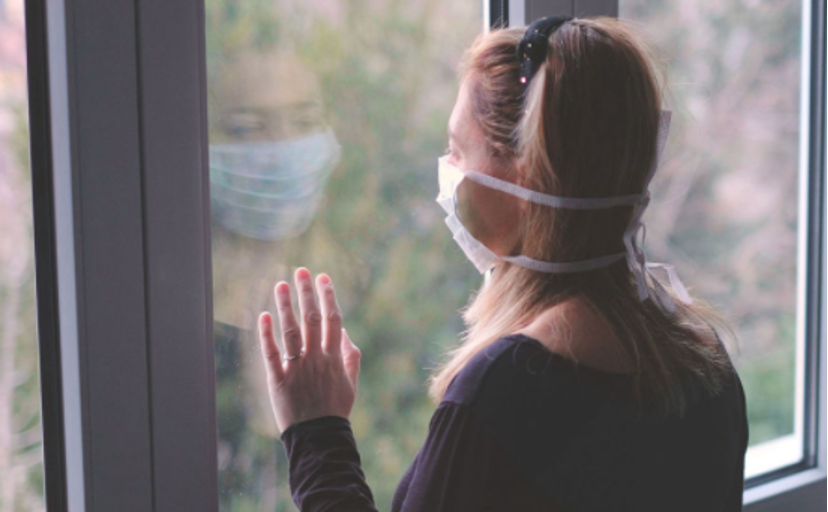 With all the talk about the trends heading in the right direction, every day we still have north of 100 people in Pima County contracting the virus. It’s still here. My point here is to remind you to please stay in touch with friends and loved ones. Our human connection is so important to both our mental and physical well-being. If you take 5 minutes per day to let someone know you’re thinking of them, it will make a huge difference.
Small Cell Poles
Our study session on cell poles is tomorrow. I have some ideas that will require the cooperation of city staff, the telecom providers, TEP and the fiber companies. Right now, I’m being told that AT&T and T-Mobile have the attitude that they don’t need to engage with anyone. According to law, they’re right. You can thank our state legislature for that. But each of my constituents is their potential customer. Pay attention to how this goes so you know which companies to support – or not.
While this mess is unfolding in many of your front yards, the state legislature continues to demonstrate how tone-deaf they are to the whole issue. Even as we’re wrestling with how we gain a voice in siting decisions, the state is considering yet 2 more bills that preempt city authority on this issue.
Right now, we can charge a fee to a telecom company for trenching in our right of way (ROW) and laying their fiber. We can’t discriminate and charge one kind of company one fee and different fees for a different sort of use (fiber vs. electric, for example), but we have the right to charge a fee based on linear feet they’ll be using the ROW. HB 2108 contains this new language:

So if this passes, the state is saying we not only have no voice in where they trench and install their systems, we cannot even treat the cell companies the same as we treat any other company when they use our Right of Way.
HB2711 relates to installing antennas on private property. This will completely take the city’s voice out of locating an antenna on private property. Here’s the language they’re adding to state statute if this passes:

The ‘Authority’ they mention would be the city. And if the state is preempting us from being a part of these arrangements, the ability of a neighborhood association or HOA to craft terms related to the installation of poles is similarly preempted.
If there was a way to get some of these poles installed in front of some legislators’ homes, that might help change the course of the conversation. Failing that, I’ll try to move the local needle on Tuesday.
COVID at College Campuses
COVID is still an issue on college campuses across the nation. U Wisconsin reported reinfections last week. The numbers are small, but they point to the continuing ‘learning as we go’ element of COVID. Right now, the immunity period after infection is thought to be around 90 days. The health care community isn’t sure how the new strains play into that. What is clear though, is that having had COVID is not guarantee that you won’t become reinfected. The experiences at Wisconsin, Madison are only the most recent examples.
As the UA opens to larger in-person classes this week, University of San Diego and Providence College are clamping down on student activities on their campuses. At USD, they’ve restricted students from leaving campus until the end of the month. It’s certainly nice to see a school with that level of concern for the wider community. And at Providence they’ve instituted a shelter in place policy (stay in your residence) with a few exceptions. Those include going to class, getting food, and other essentials. And this is in place for students registered who live both on and off campus.
U Virginia is seeing a surge in COVID cases among students. Last Tuesday and Wednesday, 397 students tested positive, and overall, 779 students, faculty and staff have active infections. School officials blamed social gatherings among students as the cause. The virus does what it does. The school is also dealing with the British variant strain, but they didn’t release data on how that is impacting this new surge. They’ve instituted a 10 day lockdown during which all club and social gatherings are banned.
A group of legislators in Kansas is pushing legislation that would give a 50% tuition refund to students who were forced to take classes remotely. I’ve written before how politics played a role in reopening decisions. So did money. Now the legislators are penalizing schools who remained in the virtual model. In Kansas, students are to be refunded ½ of their tuition for every day they were online instead of in the classroom, and 100% for days they didn’t have classes at all. For all the chatter about students needing to be in the classroom for all the good social and pedagogic reasons we know, don’t think for a moment these decisions to reopen classrooms and campuses don’t also have a financial element.
And the Foundation for Individual Rights in Education (FIRE) has had a busy year. They advocate for free speech and due process rights in education settings. What they’ve found – and I can affirm – is that COVID has put schools at odds with those principles.
In 2020, FIRE had an unprecedented number of requests for its help.
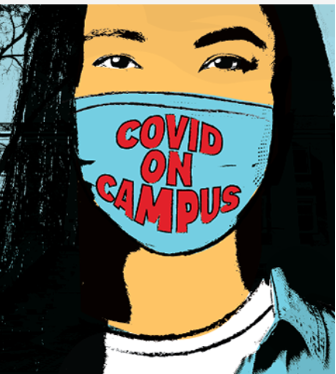
Here are some examples from what’s In a new report, issued by FIRE. Last August, 2 students in Georgia were suspended for tweeting out pictures of crowded hallways where lots of students were not wearing masks. At UCSB, it was their testing protocol (ProctorU) that came down on faculty who spoke out. The faculty board expressed its concern that ProctorU was being used as a campus surveillance tool. ProctorU sent letters charging defamation, among other things. At U Missouri, RAs in dorms tried to speak out about their safety concerns when the school began to reopen. The RAs had to speak anonymously to the media because they weren’t given clearance. At LSU, RAs were specifically forbidden from speaking to the media, including their own campus newspaper. And at Juniata College, a tenured professor was formally reprimanded for posting on social media his belief that the reopening plans would ’cause people to die.’
The UA takes the position that their elimination of my job was solely based on finances. I made $80K (having been paid at .9 FTE due to my work on the City Council) when they cut me loose after having worked there for 32 years. I had offered to drop back to .6 FTE “in order to save someone else’s job.” Compare those numbers to the $13M in coaching buyouts they paid to 2 failed football coaches in the past 3 years and now hiring a new coach with his own buyout clause.
As you know, prior to my job being eliminated I was very vocal about my displeasure at how the UA dodged its responsibility to test students living in off-campus housing. I’ve said to many of you – if a college campus is not the venue for encouraging the free expression of competing views, what is? FIRE seems to have it’s hands full these days answering that question.
|
CROWN Act
On Tuesday, I’m expecting the M&C to unanimously give direction to the City Attorney to bring us back the wording for a local CROWN Act. That’s Creating a Respectful and Open World for Natural hair. That’s very simply our local prohibition against discrimination based on natural hair. Nobody should be treated differently due to the texture of their hair. Honestly, I was surprised it was even an issue, until I saw the video of the poor guy who was forced to cut his hair in order to compete in a wrestling tournament.
At Dartmouth, students are testifying at the state level in an attempt to get their own CROWN Act adopted. One of the students shared a memory she had during a Professional Development workshop that was being held for black women. It was led by another black woman. Attendees were advised ‘not to wear afro’s, natural hair or protective styles in professional interviews.’ Another of the students testifying said she was told during a theater rehearsal that her hair was ‘impeding the rehearsal process.’ Sponsoring state representative Mary Beth Walz is quoted as saying “the goal of my testimony is to make it clear that race-based discrimination is real.”
Other states are joining that New Hampshire effort. So are cities. I’m grateful to the community members who have brought this issue forward so Tucson can join as a leader in shutting down every vestige of discrimination that exists in our community.
Film Tucson
I haven’t given an update on what the Visit Tucson film office has been up to for a while. Even without the help of our state legislature, they’ve been busy.
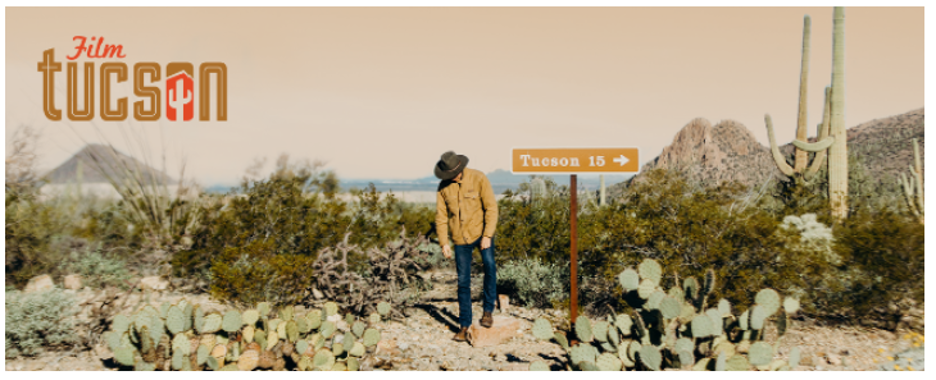
Without state incentives, we don’t play in the major motion picture world these days. But there are plenty of other areas we’re involved with that keep Tucson and Southern Arizona in the film game. Some examples; VH1 needed a resort location for a season of Family Reunion: Love & Hip-Hop Edition. They ended up out at El Conquistador. Think of the backdrops their video had to work with.
Discovery Channel shot Naked & Afraid, using locations in both Pearce and in Tubac. That brought over a month worth of shoot days – which means over a month of rooms in hotels, car rentals, food catering, and crew/cast work. And ABC filmed an episode of The Great Christmas Light Fight. It’s a comedy that brought a week of shoot time that’ll air later this year.

Advertisers who have worked through Visit Tucson’s film office include Kenworth Trucks, and Samsung. When you see this image on a Kenworth ad, you’ll know it was done through our film office efforts.
While jobs are being lost, and hours cut back in lots of sectors of the economy, the film industry touches such a variety of them that getting Arizona back to a position where we can compete for large films would be a boost to our economy. It’s something that’ll have to come out of Phoenix. Anecdotally, about 5 years ago, Jonathan and I met with then state Rep. Andy Biggs to pitch a state film incentive. Biggs, now of January 6th insurrection fame, rejected the idea. That is a failure to understand this basic economic principle: you’ve gotta break eggs to make bread. The meeting was an hour wasted out of Jonathan and my life.
|
New COVID Variant Strains
Three weeks ago there were 437 total cases of the variant COVID strains identified in the U.S. Arizona had not been impacted. Last week we were up to 997 cases of the new strains, and had Arizona joined the map where they’ve been discovered. This week the number of new strain cases has increased to 1,549, spread among 42 states. Arizona has had 6 cases of the British strain reported. If the county is forced to eliminate testing due to Ducey withholding funds, we won’t have any way of tracking the new strains.
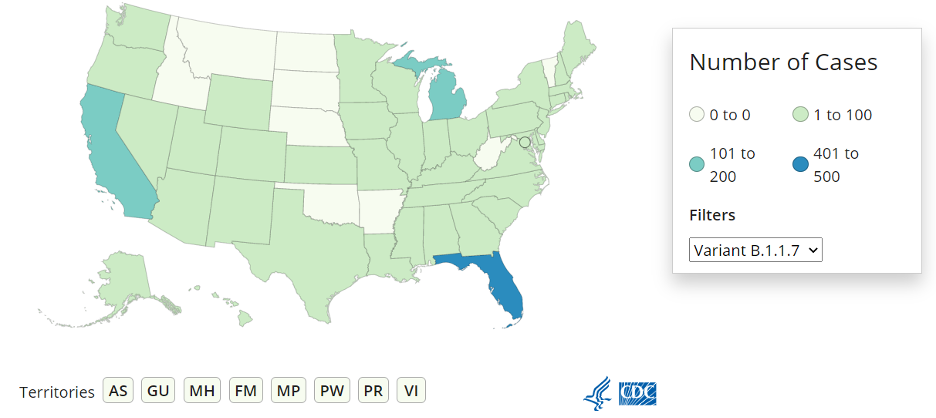
The CDC is working with health agencies to encourage testing for the new strains. When, during our joint city/county meeting last week, one of our county colleagues said he felt testing wasn’t worth investing in, I reminded him that it’s our sole effective way of isolating infected people, contact tracing and managing community spread. With the new strains’ increased infectivity rate, that’s even more true than before.
The Governor’s office is withholding hundreds of millions of dollars in COVID testing money. If the county decides it cannot continue deficit spending in order to fund testing, that decision will fall at the feet of Ducey and his administration. In the past 3 weeks the total of new strains in the U.S. has quadrupled. Pretending it doesn’t exist doesn’t make that so.
COVID Risk in Pima County
As noted, we’re on a good trend line. These are the new COVID cases for Pima County that came out in a report shared by the County Administrator last week. Having over 1,400 cases in a week is still very high – but the trend is what we’re watching. And that’s headed in a good direction.
As I mentioned in the section above, testing is our tool to monitor community spread. The county is right now headed towards a deficit situation for this fiscal year if they aren’t reimbursed for testing costs they incurred in an effort to address the pandemic. Given that, effective March 3rd, they may shut down their testing alternatives and let the state pick up the work, and the tab. They seem to have a willing partner on campus – we'll see how that works out for them, and for the region.
In Arizona we are now over 800,000 total COVID cases since this all began. We have had over 15,000 of our friends and loved ones die from the virus. For the past month I’ve shared the week by week trend of new cases in Pima County. The downward slope, although gradual is still headed in the right direction. Here is now a 5-week comparison:
A month ago when I first shared the weekly count, we were seeing days with over 1,000 new cases in Pima County. Now they’re generally in the 200 range. And this reminder – context is important. The last time we saw numbers even close to these was back at the end of May last year. That was immediately prior to the summer surge. We’ve had over 1,000 more cases in February so far than we had in the entire month of June last year. Contrary to one guy from the Board of Supervisor’s opinion, now is not the time to let your protective guard down.
Across the nation the trend also continues to be positive. These are the Harvard Global Health Institute risk maps from the past 2 weeks. Arizona has moved from being completely in the red to where we’re now completely in the orange risk level. That's still a significant risk, but it also shows we’re going in the right direction.
 This week:
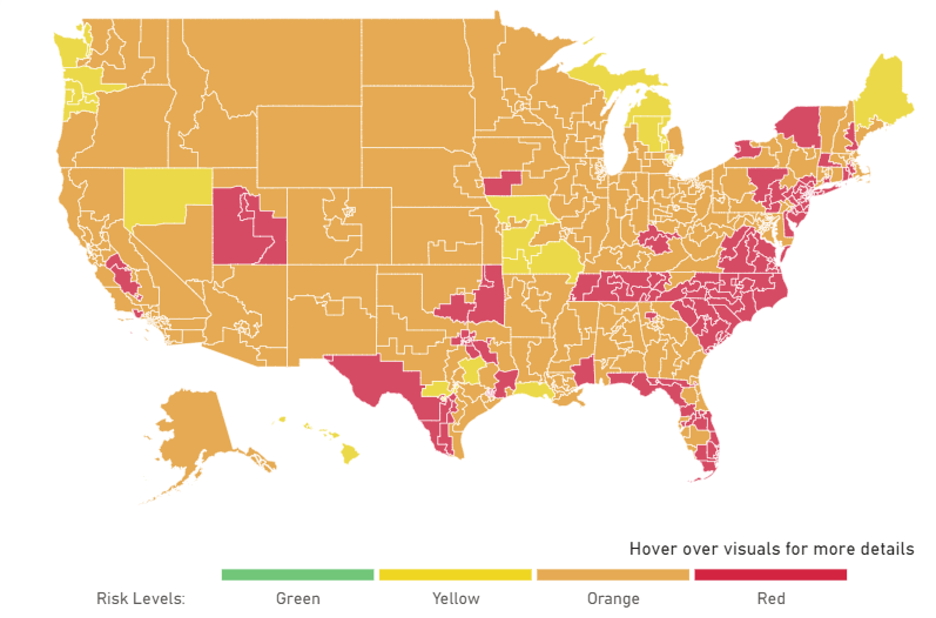
The data also points to promising signs for reopening schools. Last week all three of these criteria were in the red. There is some improvement:
 These metrics didn’t change last week.
 And there is improvement in these. They were all in yellow last week.

For reopening, they’re looking for 2 consecutive weeks of all 9 standards being in either yellow, or green.
Here’s our statewide map. I’ve been sharing these weekly for nearly a year now. Time flies...
The infectivity rate continues to be headed in the right direction. The goal is, of course, zero, but anything below 1.0 is good news. Shortly after the UA reopened in the fall, that zip code was over 2.0. Now you can see the improvement. There wasn’t any change in the UA area value this week, but the other 2 areas went down.
Responsible health care officials are saying this is now a footrace between continuing the slow declines we’re seeing in COVID-19, spread of the new variant strains, and getting vaccines out widely. Please continue the CDC-recommended safe behavior activities you’re doing, and watch the vaccination chart for when it’s your turn to register for that.
For the NY Times data sets, use this link:
The State Department of Health site is at this link: www.azdhs.gov.
UA Law Speaker Series Online Event
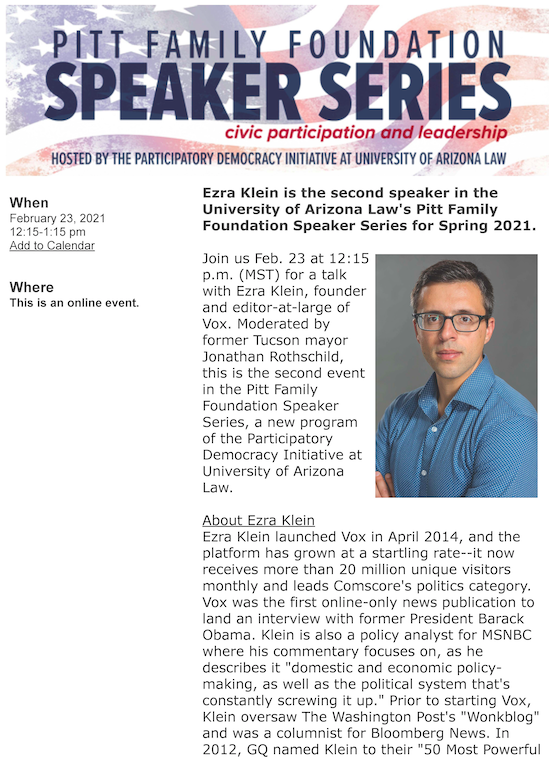
Sincerely,

Steve Kozachik
Council Member, Ward 6
ward6@tucsonaz.gov

City of Tucson Resources
|